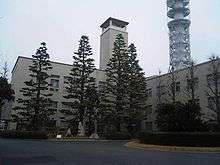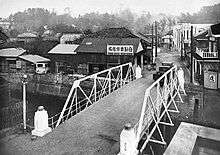Fujisawa, Kanagawa
| Fujisawa 藤沢市 | |||
|---|---|---|---|
| City | |||
|
A panorama view of Fujisawa, from Enoshima seaside | |||
| |||
 Location of Fujisawa in Kanagawa Prefecture | |||
 Fujisawa
| |||
| Coordinates: 35°21′N 139°28′E / 35.350°N 139.467°ECoordinates: 35°21′N 139°28′E / 35.350°N 139.467°E | |||
| Country | Japan | ||
| Region | Kantō | ||
| Prefecture | Kanagawa Prefecture | ||
| Area | |||
| • Total | 69.57 km2 (26.86 sq mi) | ||
| Population (February 1, 2015) | |||
| • Total | 420,254 | ||
| • Density | 6,040/km2 (15,600/sq mi) | ||
| Time zone | Japan Standard Time (UTC+9) | ||
| - Tree | Japanese black pine | ||
| - Flower | Wisteria | ||
| - Bird | Common kingfisher | ||
| Phone number | 0466-25-1111 | ||
| Address | 1 Asahi-cho, Fujisawa-shi, Kanagawa-ken 251-8601 | ||
| Website |
www | ||

Fujisawa (藤沢市 Fujisawa-shi) is a city in Kanagawa Prefecture, Japan.
As of February 2015, the city had an estimated population of 420,254 and a population density of 6,040 people per km². The total area is 69.57 km².
Geography
Fujisawa is in the central part of the Kanagawa Prefecture. It faces Sagami Bay of the Pacific Ocean. The northern part of the city is on the Sagamino plateau while the southern part is on the Shonan Dunes. Fujisawa has three major topographical features: the island of Enoshima to the south connected to the Katase shoreline area by a road bridge, and two rivers, the Hikichi (引地川) and the Sakai (境川), which run north-south.
The Hikichi can be traced from an area designated as a nature reserve park in the city of Yamato and flows directly along the boundary of the joint US Navy and Japan Maritime Self-Defense Force Atsugi Naval Air Base and the United States Army Camp Zama. The Sakai runs directly from the mountains between Machida and Hachioji, and for quite some distance forms the border between the Tokyo Metropolitan Area and Kanagawa Prefecture. From Machida city centre, the river can be directly followed by a foot and cycle path to Fujisawa city centre, a distance of approximately 35 kilometers. Another cycle path runs along the Shonan Coastal path, from the Sagami River, in Hiratsuka, to Enoshima Bridge in Fujisawa.
Surrounding municipalities
Climate
| Climate data for Tsujido, Fujisawa(1992 - 2010) | |||||||||||||
|---|---|---|---|---|---|---|---|---|---|---|---|---|---|
| Month | Jan | Feb | Mar | Apr | May | Jun | Jul | Aug | Sep | Oct | Nov | Dec | Year |
| Record high °C (°F) | 18.6 (65.5) |
22.1 (71.8) |
22.3 (72.1) |
27.2 (81) |
29.6 (85.3) |
32.1 (89.8) |
36.2 (97.2) |
36.7 (98.1) |
36.5 (97.7) |
31.0 (87.8) |
24.7 (76.5) |
22.6 (72.7) |
36.7 (98.1) |
| Average high °C (°F) | 10.8 (51.4) |
11.4 (52.5) |
13.9 (57) |
18.4 (65.1) |
22.1 (71.8) |
24.8 (76.6) |
28.1 (82.6) |
30.1 (86.2) |
27.4 (81.3) |
22.6 (72.7) |
17.7 (63.9) |
13.3 (55.9) |
20.1 (68.2) |
| Daily mean °C (°F) | 6.1 (43) |
6.7 (44.1) |
9.6 (49.3) |
14.3 (57.7) |
18.3 (64.9) |
21.5 (70.7) |
24.9 (76.8) |
26.6 (79.9) |
23.7 (74.7) |
18.5 (65.3) |
13.3 (55.9) |
8.5 (47.3) |
16.0 (60.8) |
| Average low °C (°F) | 1.6 (34.9) |
2.0 (35.6) |
5.1 (41.2) |
10.0 (50) |
14.8 (58.6) |
18.7 (65.7) |
22.5 (72.5) |
24.0 (75.2) |
20.6 (69.1) |
15.0 (59) |
9.2 (48.6) |
4.1 (39.4) |
12.4 (54.3) |
| Record low °C (°F) | −3.5 (25.7) |
−5 (23) |
−1.4 (29.5) |
−0.2 (31.6) |
7.1 (44.8) |
12.3 (54.1) |
16.7 (62.1) |
18.0 (64.4) |
12.2 (54) |
7.4 (45.3) |
2.1 (35.8) |
−3.5 (25.7) |
−5 (23) |
| Average precipitation mm (inches) | 66.4 (2.614) |
57.7 (2.272) |
139.2 (5.48) |
133.5 (5.256) |
157.4 (6.197) |
165.6 (6.52) |
181.4 (7.142) |
137.3 (5.406) |
191.3 (7.531) |
182.7 (7.193) |
104.1 (4.098) |
59.3 (2.335) |
1,564.9 (61.61) |
| Average precipitation days (≥ 1.0 mm) | 6.6 | 5.9 | 10.7 | 9.8 | 11.5 | 12.2 | 10.5 | 6.6 | 10.1 | 10.3 | 7.8 | 5.3 | 107.3 |
| Mean monthly sunshine hours | 178.3 | 169.4 | 168.8 | 175.9 | 170.4 | 126.9 | 167.9 | 208.7 | 144.2 | 140.5 | 147.9 | 174.4 | 1,974.7 |
| Source #1: Japan Meteorological Agency | |||||||||||||
| Source #2: 観測史上1〜10位の値(年間を通じての値) | |||||||||||||
History

The area around present-day Fujisawa City has been inhabited for thousands of years. Archaeologists have found stone tools and shell middens from the Japanese Paleolithic period, ceramic shards from the Jomon period, and graves from the Kofun period at numerous locations. The area is mentioned in the Nara period Nihon Shoki chronicles. By the Heian period, central Sagami Province was divided into shōen controlled by the Muroaoka, Oe, and other local warlords. During the Kamakura period, Fujisawa was the setting for a number of battles to overthrow the Kamakura shogunate as mentioned in the late 14th century Taiheiki. During the Muromachi period, Fujisawa developed around Yugyo-ji, a Buddhist temple, which was established in 1325.
With the Edo period, Fujisawa prospered as Fujisawa-shuku, a post station on the Tōkaidō highway connecting Edo with Kyoto. Shogun Tokugawa Ieyasu built a palace in Fujisawa as a rest stop between Edo and Sunpu.
Following the Meiji Restoration, the area was divided into villages in Kōza District and Kamakura District within Kanagawa Prefecture. The Kōza District office was located in Fujisawa from 1878. The area developed rapidly after the opening of Fujisawa Station of Tōkaidō Main Line in 1887.
During the cadastral reform of April 1, 1889, Fujisawa-Ōsaka Town (in Kōza District) and Fujisawa-Ōtomi Town (in Kamakura District) were created through the merger of local hamlets. Emperor Meiji visited Fujisawa in 1891 to watch military maneuvers. The IJA 49th Infantry Regiment under the IJA 1st Division was stationed in Fujisawa from 1907. During the same year, Fujisawa-Ōsaka Town absorbed Fujisawa-Ōtomi Town and expanded further in 1908 by annexing the neighboring villages of Kugenuma and Meiji (both from Kamakura District), renaming itself Fujisawa Town.
The 1923 Great Kanto earthquake caused severe damage to Fujisawa, with some 4,000 houses destroyed. An Imperial Japanese Navy Artillery School was established in Tsujido in 1926.
The town of Fujisawa was elevated to city status on October 1, 1940. Fujisawa expanded by annexing the village of Muraoka in 1941, the village of Mutsuai in 1942, the town of Katase in 1947, and the villages of Goshomi, Chogo, Takakura and parts of Koide (hamlet of Endo) in 1955. Fujisawa hosted the yachting events of the 1964 Summer Olympics.
These improved transport links, such as the Yokohama Subway line and express train services on the Odakyu line, have made Fujisawa an increasingly attractive and cost-effective commuter suburb for Tokyo and Yokohama.
Economy
Fujisawa has a mixed economy with a strong industrial base. Isuzu retains a large truck factory at Tsuchidana. Kobe Steel has a factory in the east of the city, as does NSK Microprecision, a maker of bearings and precision parts. Sony operates the Shonan Technology Center in Fujisawa.[1] Ebara Corporation, a major manufacturer of pumps and water treatment equipment has a plant in Fujisawa.[2]
Fujisawa has extensive commercial shopping facilities and has the largest commercial city centre on the Shonan coast. Fujisawa is also a bedroom community for Yokohama and Tokyo.
Transportation
Railway
- JR East - Tōkaidō Main Line, Shōnan-Shinjuku Line
- Odakyu Electric Railway – Odakyū Enoshima Line
- Enoshima Electric Railway
- Enoshima • Shōnankaigankōen • Kugenuma • Yanagikōji • Ishigami • Fujisawa
- Sagami Railway - Izumino
- Yokohama Municipal Subway – Blue Line
- Shonan Monorail
Highway
Education
Fujisawa has the usual range of city and prefectural schools, including Shonan High School, one of the leading high schools in Kanagawa with former Tokyo Governor Shintaro Ishihara as a graduate. There are a number of similar private institutions.
There are four university campuses in Fujisawa: prestigious Keio University's Shonan Fujisawa Campus (SFC) with three faculties and a graduate school in Endo, Nihon University's School of Natural Science at Mutsuai, and Tama University's Global Studies Faculty near Shonandai, all in the northern part of the city, and the Shonan Institute of Technology (SIT) in Tsujido Nishikaigan to the south.
Hospitals
Sister city relations
 Miami Beach, Florida, USA (from March 5, 1959)
Miami Beach, Florida, USA (from March 5, 1959) Matsumoto, Nagano, Japan (from July 29, 1961)
Matsumoto, Nagano, Japan (from July 29, 1961) Kunming, Yunnan Province, China (from November 5, 1981) (Friendship city)
Kunming, Yunnan Province, China (from November 5, 1981) (Friendship city) Windsor, Ontario, Canada (from December 2, 1987)
Windsor, Ontario, Canada (from December 2, 1987) Boryeong, South Chungcheong Province, South Korea (from November 15, 2002)
Boryeong, South Chungcheong Province, South Korea (from November 15, 2002)
Local attractions
Fujisawa remains at the centre of the 'Shōnan lifestyle' image, and its good rail and adequate road connections make it a very popular destination for day trippers from the Kanto region. Surfing and beach volleyball tournaments in summertime attract visitors, especially younger people, and they are also drawn to the seasonal bars and rest houses that are erected along the beach from Kugenuma Kaigan to Enoshima Kaigan.
Fujisawa has two major firework displays in the summer, in late July and early August, usually sandwiched in between similar festivals in Chigasaki, Hiratsuka, Kamakura, and Yokohama.
Enoshima Island has many attractions, including a botanical gardens and Enoshima Lighthouse which is open to visitors. Its height of 119.6 meters above sea level affords an excellent view of the area and, on a clear day, Mount Fuji. There are a number of famous Shinto shrines, some in caves on the south side of the island.
One of Fujisawa's most popular seasonal products is shirasu, similar to but much smaller and softer than whitebait.
Tourist attractions
- Enoshima Island
- Shirahata Shrine: Shirahata Jinja is a Shinto shrine, dedicated to Samukawahiko-no-Mikoto and Minamoto no Yoshitsune. There are two portable shrines, Yoshitsune and Benkei. Yoshitsune and Benkei were major Japanese historical figures of the late Heian period.
- Shōjōkō-ji (Yugyo-ji): head temple of the Ji-sect of Japanese Buddhism
- Kugenuma Beach
- Site of Oba Castle
Notable people from Fujisawa
- Rika Fujiwara, professional tennis player
- Akira Hatano, politician
- Motohisa Ikeda, politician
- Tsubasa Imai, singer, actor
- Masahiko Kageyama, racing driver
- Chihiro Kato, professional volleyball player
- Masahiko Kumagai, professional soccer player
- Takahiro Mizushima, voice actor
- Masahiro Nakai, singer, actor
- Tsuneko Nakazato, author
- Hikaru Nishida, singer, actress
- Nagisa Oshima, film director
- Shinnosuke Ogasawara, professional baseball player
- Ikuzo Sakurai, politician
- Tomoaki Satoh, professional baseball player
- Go Soeda, professional tennis player
- Haruka Suenaga, gravure model
- Kohei Suwama, professional wrestler
- Shuhei Takahashi, professional baseball player
- Saki Takaoka, actress
- Toshitaka Tsurumi, professional soccer player
References
- ↑ "Access & Map." Sony. Retrieved on January 19, 2009.
- ↑ Ebara official home page
External links
| Wikimedia Commons has media related to Fujisawa, Kanagawa. |
- Official website (Japanese)
 Fujisawa travel guide from Wikivoyage
Fujisawa travel guide from Wikivoyage



